Post by Natalie Robison (she/her), undergraduate in Biology at Portland State University pursuing an Interdisciplinary Neuroscience minor.
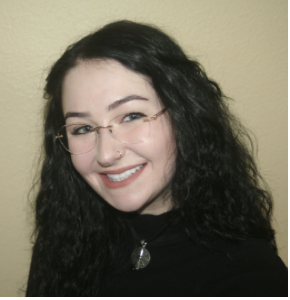
Did you know that, by some measures, a brain has just as many glial cells as it does neurons?
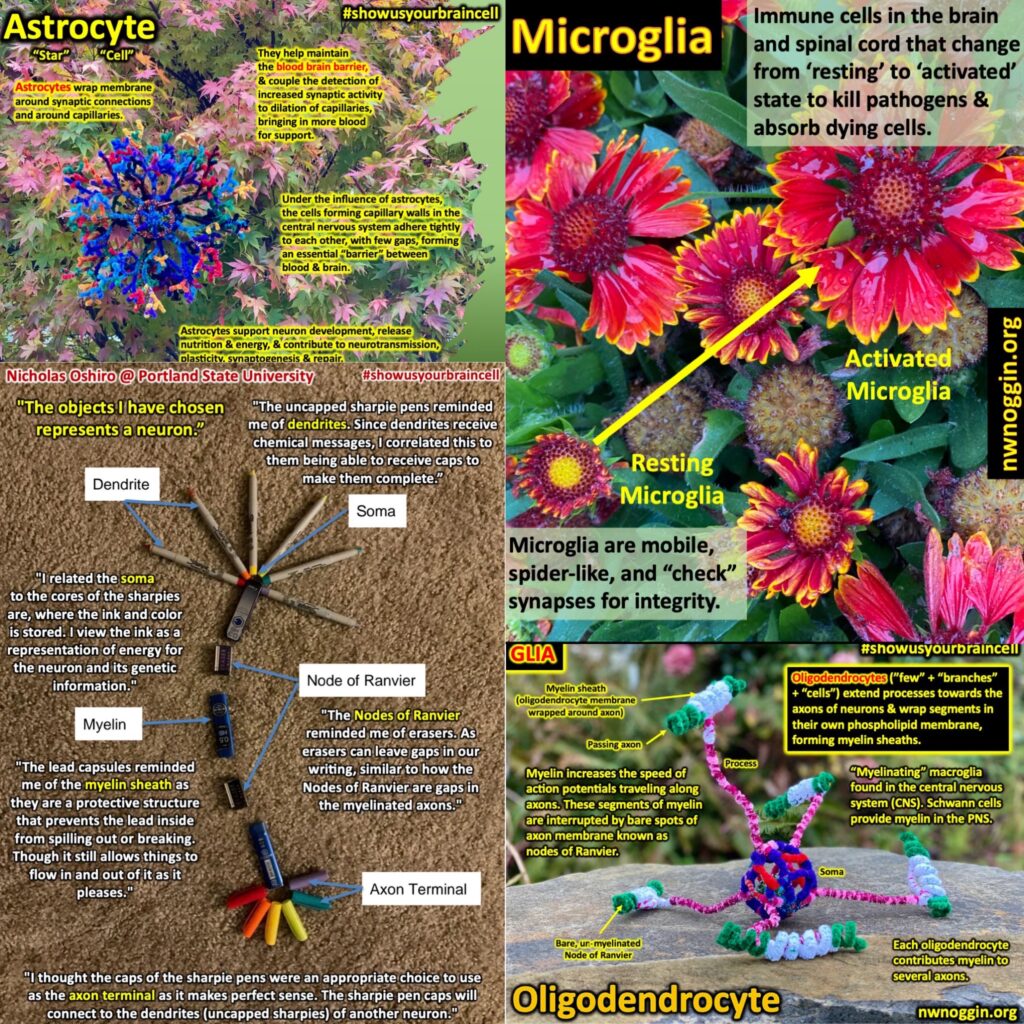
LEARN MORE: The search for true numbers of neurons and glial cells in the human brain
“Look for the helpers.”
— Fred Rogers
Imagine a classroom with a one-to-one student to teacher ratio; the unique needs of each student could be identified quickly and addressed with the appropriate response. You’d be pretty confident that each student would be capable of reaching their full potential, right?
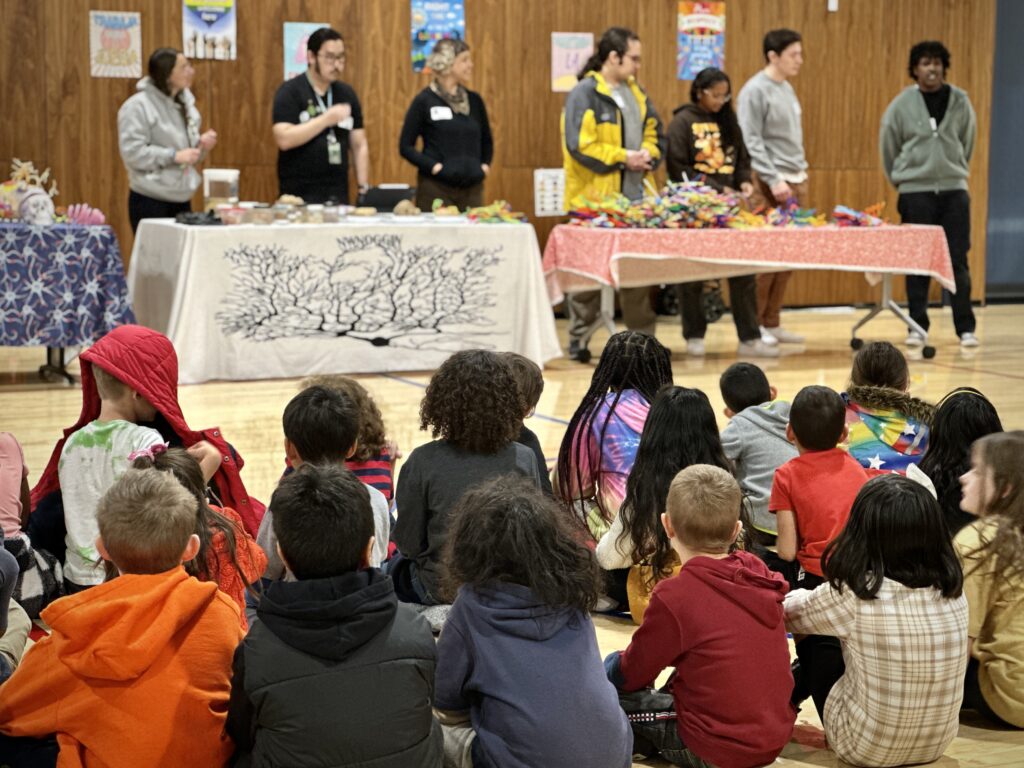
This ratio isn’t common in the U.S. education system, but it’s roughly the case in our brains.
This is because glia – the cells which provide structural, nutritional, regulatory, and immunological support to neurons – act in the role of teachers. Teachers support students by identifying their needs, connecting them to resources, and guiding them towards their goals. Our wonderful, complex brains are fine-tuned to maximize the efficiency of neuron communication – so that they can produce, well, your conscious experience such as in this very moment.
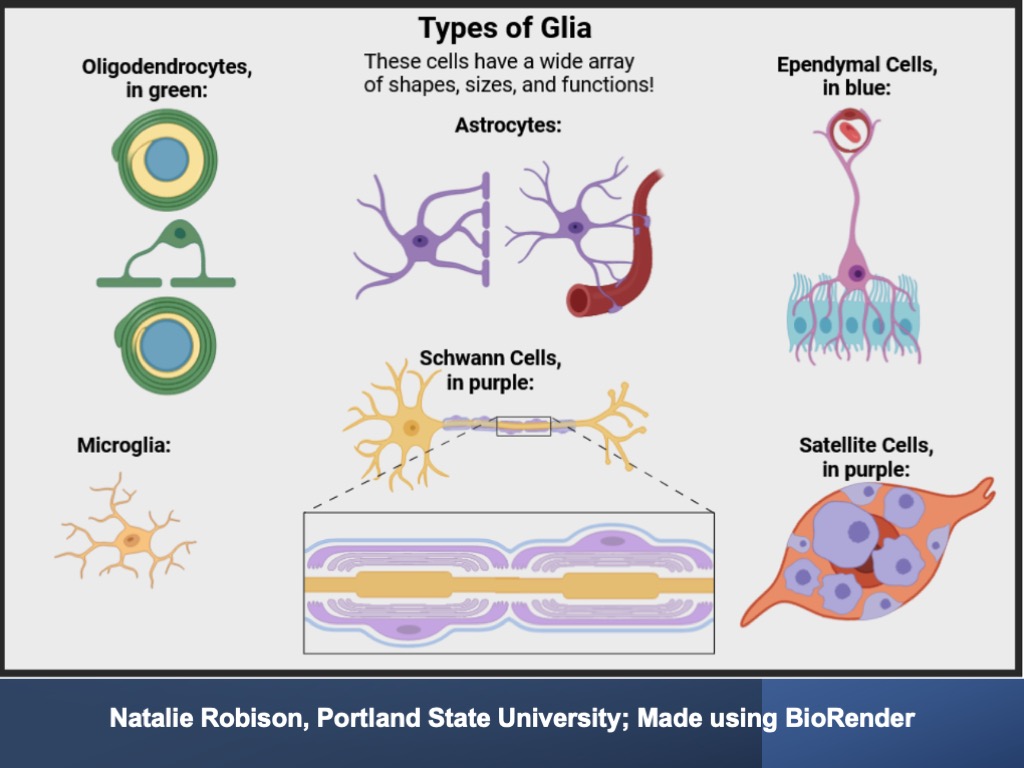
LEARN MORE: BioRender
LEARN MORE: What about the glia?
LEARN MORE: Glia as Architects of Central Nervous System Formation and Function
LEARN MORE: Glial Cells and Their Function in the Adult Brain
LEARN MORE: Glia as sculptors of synaptic plasticity
Without glia, neurons would have a hard time doing their job. They would have a hard time making first contact with each other, and in managing the connections they have established – should a synapse, for example, be strengthened or severed? The neurons could be damaged by immune cells trying to “clean up” the convoluted network, and neurons would struggle to maintain access to oxygen and nutrients.

FUN FACT: The human brain (2% of your body) consumes ten times more energy (20%!) than expected from mass alone. Having a brain takes a lot of work… literally!
LEARN MORE: Brain power
LEARN MORE: Sugar for the brain: the role of glucose in physiological and pathological brain function
Why neuroscience?
Can you imagine how difficult it would be for a brain to function without the extensive support system of glial cells? Well, that’s how it has felt for me to pursue neuroscience at the undergraduate level. I’d like to share my story of how I became fascinated with neuroscience, how I pursued it at my university, the limitations I faced, and what could be done better.
GET TO KNOW ME: I have always been an outlier for many reasons, and that’s exactly why I pursue neuroscience so passionately.
I grew up with a predisposition towards science, but my school was rural and underfunded. While I earned good grades and showed dedication, by the end of high school I was academically left behind. I’m sure I could have gotten support if my needs were more one-dimensional and easily identifiable, but I was dealing with compounding intersectional identities. I come from a low-income household where those I loved struggled with severe addiction and bipolar disorder, a cycle of intergenerational trauma, I was yet to be diagnosed as on the autism spectrum or with treatment-resistant major depression, I was openly queer in a less-than-accepting town (now, openly lesbian), and before my neurocardiac condition was diagnosed I was that kid who was constantly out of breath and sometimes randomly fainted (more on that later).
I’m proud of how long I maintained a high-functioning facade before my mental health revoked my self-perception as a part of the world which surrounded me.
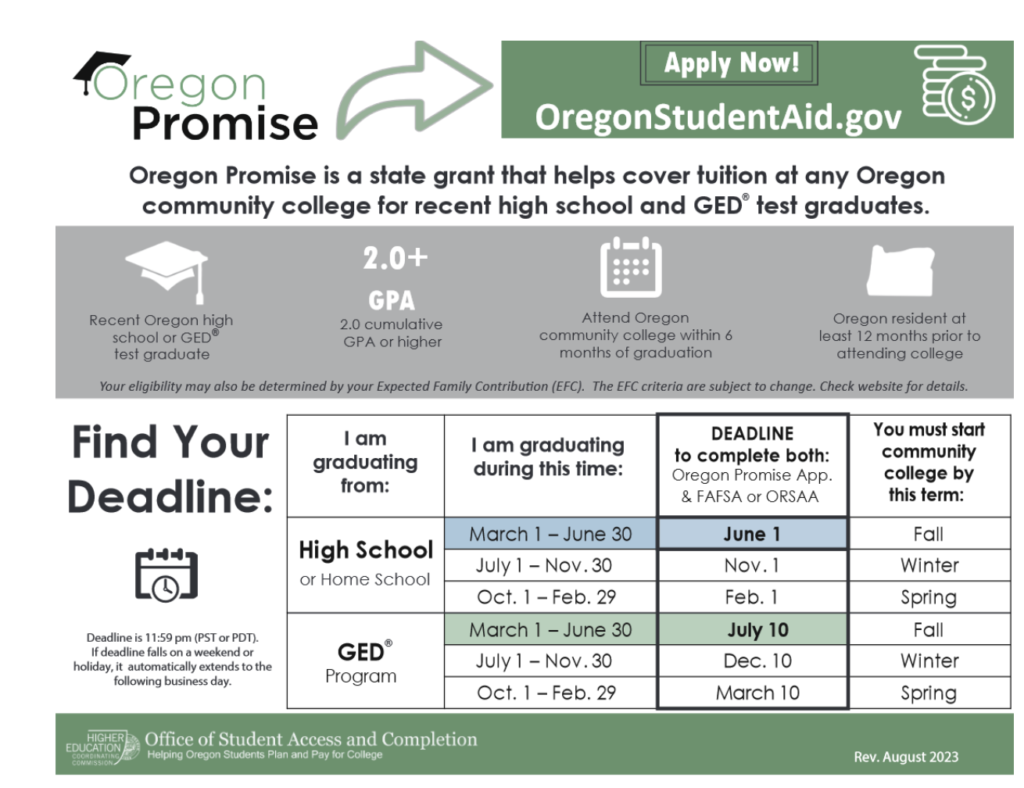
IMAGE SOURCE: Oregon Student Aid
LEARN MORE: Intersectionality in Public Health Research: A View From the National Institutes of Health
LEARN MORE: Intersectionality: a means for centering power and oppression in research
Even though I was still fiercely curious, I had no direction after high school graduation. As a low-income student, I recognized that the Oregon Promise Grant was my only chance to afford any form of college education, so I enrolled in my local community college.

The COVID pandemic was just beginning, an era of mental anguish for many, but I had accidentally stumbled upon my ideal conditions for healing and growth. Constant isolation, learning how to study, access to mental health treatment through my community college, and simply having room to explore who I was finally allowed me to develop a sense of identity.
Clackamas Community College was the first environment where I was academically and personally supported, and the way I perceived the world around me changed completely (it’s almost like the two are… related?). I experienced a personal renaissance which established a fractal pillar of my identity: I reclaimed my fierce scientific interest in a manner that also strongly provoked my curiosity.
This demonstration of the power of our brains is why I am fascinated with neuroscience.
I became a math and science tutor at community college. I hadn’t anticipated becoming so passionate about it that I’d continue to tutor to this day, but through tutoring I was combining all of my interests: academic subjects like biology and chemistry, direct support for those in my community, and even socioeconomic analysis when relevant to student needs. I was surprised at how often students struggled with their academic self-perception, or the need to navigate their material conditions to support their learning process. In other words, I worked with students to analyze their academic goals in terms of what holds them back: how to structure study hours while working three jobs, using assistive technology to overcome language barriers, navigating the disability resource center and classroom accommodations, and developing self-motivation in place of external motivation. As my tutoring position transitioned to a mentoring role, I found myself asking questions that neuroscience might answer: e.g., what is the impact of all these different factors – sleep, diet, mental health, and more– on the brain’s ability to process and function? While my personal experience set deep roots for my interest in the brain, tutoring demonstrated that my life is but one example from the whole world of neuroscience.
How did I pursue neuroscience?
As a Clackamas Community College student I joined the BUILD EXITO program to develop my academic identity. As a BUILD EXITO Scholar I was provided academic guidance in the form of career mentoring, peer mentoring, and weekly learning sessions with my cohort on how scientific research is conducted. By the end of that school year, I was the only member of my community college cohort left.
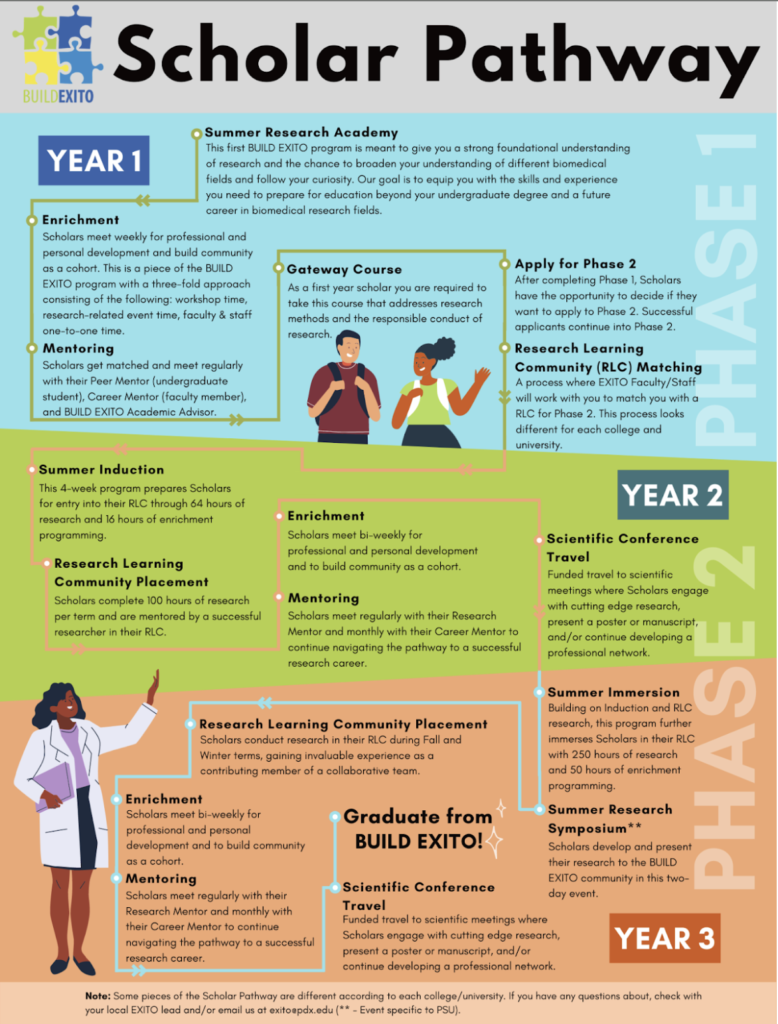
LEARN MORE: BUILD EXITO is just one of numerous programs hosted in the Portland State University Center for Internship, Mentoring, and Research (CIMR).
The more I learned about science research the more excited I grew to finally join in.
Outside of work and school I read books and academic literature on the brain, consciousness, and perception, almost like an extracurricular activity. I was a determined Biology major with aspirations in Neuroscience, and I transferred my education to Portland State University to continue my work in the BUILD EXITO program.

As a PSU student I was ecstatic to declare a minor field of study in Interdisciplinary Neuroscience. Biology was a challenging major, and it wouldn’t be until my senior year– maybe junior year– that I could finally take a class that was about neurons or cognitive processing. Thankfully my position as a BUILD EXITO Scholar helped me fill the gap in the meantime.
At PSU I was able to participate in funded biomedical research at a BUILD EXITO partnered lab, taking an active role in my local scientific community. I connected to a lab studying one of my favorite subjects: language.
I became a research assistant under Dr. Carolyn Quam at the Child Language Learning Center, located within the Speech & Hearing Sciences Department at Portland State University. We use eye-tracking methods to investigate language attrition in Mandarin-English bilingual adults.
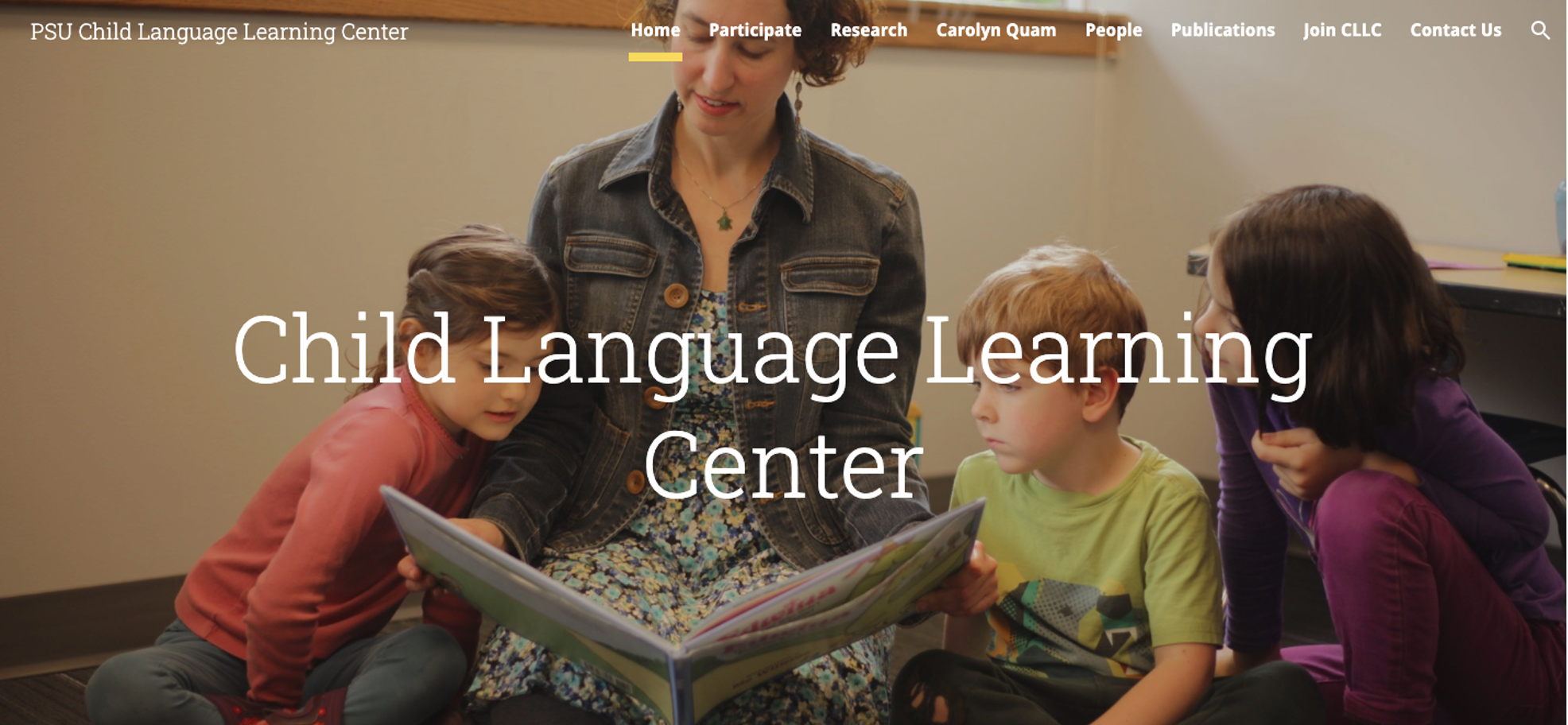
LEARN MORE: Voices of Two Worlds: Delving into Mandarin-English Bilingualism
Researching the neuroscience of language at PSU
English is an intonational language, meaning pitch is used to indicate a question versus a statement. Some languages are tonal, like Mandarin Chinese, meaning they use pitch to indicate the meaning of a word. For instance, the Mandarin word /he/ means “drink” when spoken with a high, level tone, or “river” when spoken with a rising tone (like you would to indicate a question in English). We study those who are bilingual between these two languages (and thus, two systems of how pitch is used to communicate meaning) because of an interesting effect: Those who are more English dominant appeared to lose proficiency in Mandarin tones, while their proficiency in Mandarin vowels is seemingly unaffected. It’s expected that one’s skills in a language would weaken if they use it less; we investigate why this appears to be an unequal loss (or, attrition) in the case of Mandarin-English bilinguals.
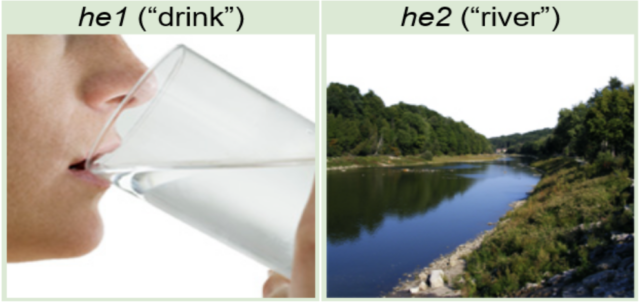
Example of a tone trial, where the tone is used to differentiate between these words
How do we investigate this?
We test the performance of Mandarin-English bilinguals on tasks which rely on proficiency in specific language categories (examples below). We study those with varying degrees of dominance in either language so as to reveal the effect of becoming English dominant on Mandarin proficiency. The tasks may utilize tonal information, vowel information, or a combination of tonal, vowel, and consonant information (as a baseline). We hypothesize that the degree to which proficiency in a language category is lost has a relationship with how easily the language category assimilates between the two languages. For example, Mandarin vowels that are equivalent to English vowels would not show attrition compared to Mandarin vowels that do not have an English equivalent – these vowels would show attrition similar to that of Mandarin tones because, being an intonational language, English has no equivalent tone.
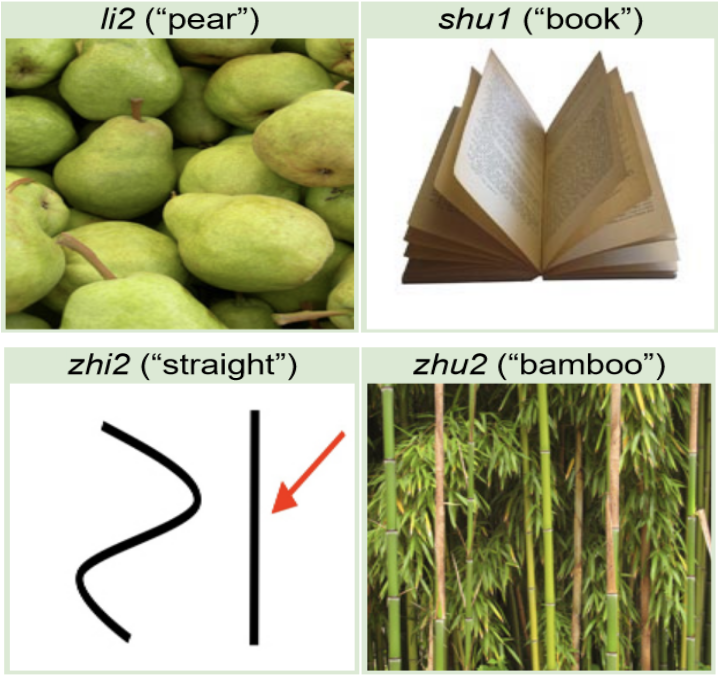
Examples of a baseline trial (left) and a vowel trial (right)
How and why do we use eye tracking?
Listening to, thinking about, and producing language is a process which is mostly subconscious. It’s like breathing, or blinking: if you don’t think about it then it’s automatic, but if you take the time to pay attention to it then suddenly you are only breathing because you actively choose to do so (you’re welcome, for bringing that to your attention). With our research, we want to study language as an automatic, subconscious process, and the more layers of control there are (i.e., speaking, writing something down) the more steps along the way that the process could become conscious– especially since our subjects know they are being observed. Eye tracking is a method of observing subconscious language processing because eye movements are rather automatic (especially in the first couple of seconds of a trial) and they represent what the subject is directing their mental attention to. We organize the data as either “looks to the correct answer” or “looks to the incorrect answer” then combine those values into a ratio called Target Advantage (TA). Target Advantage refers to the higher likelihood of fixating one’s gaze on the correct answer, and a lower value indicates that the subject was less certain in their information processing. Part of my contribution to this line of research is investigating whether there are any other valid uses of eye-tracking data in order to answer our research questions.
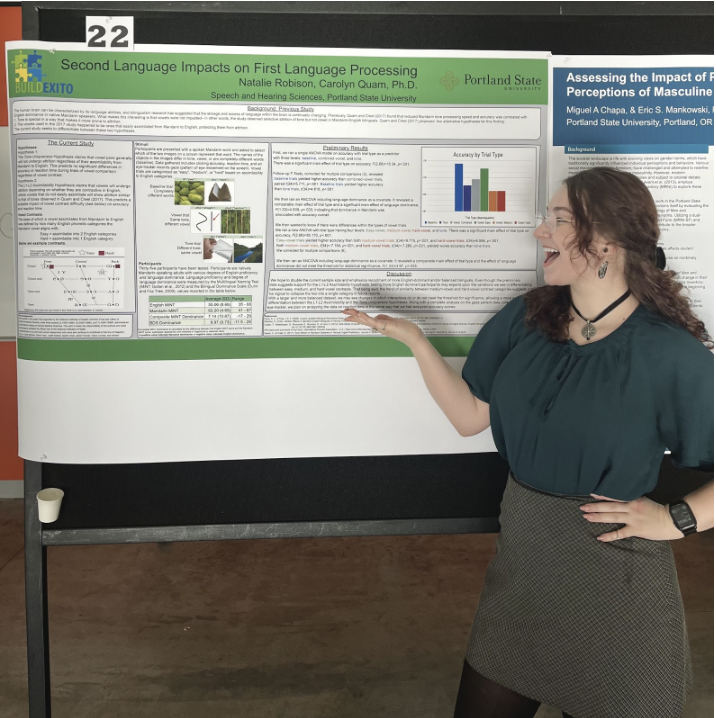
I expect to publish my undergraduate thesis on my contributions to this project in Spring of 2024. I will produce an informed yet speculative analysis on the neural networks involved in generating the effects being measured (i.e., tonal processing versus vowel processing).
My undergraduate research experience taught me a lot in a short amount of time. In the first month of my experience, my peer research assistant Amy Lin and I formed a team under Dr. Carolyn Quam to participate in a program on policy advocacy. Through Scholars Transforming through Research we studied how to use positions in science and research to effectively advocate for evidence-based solutions to all levels of governance. We even got to meet Congressman Don Beyer (pictured below)!
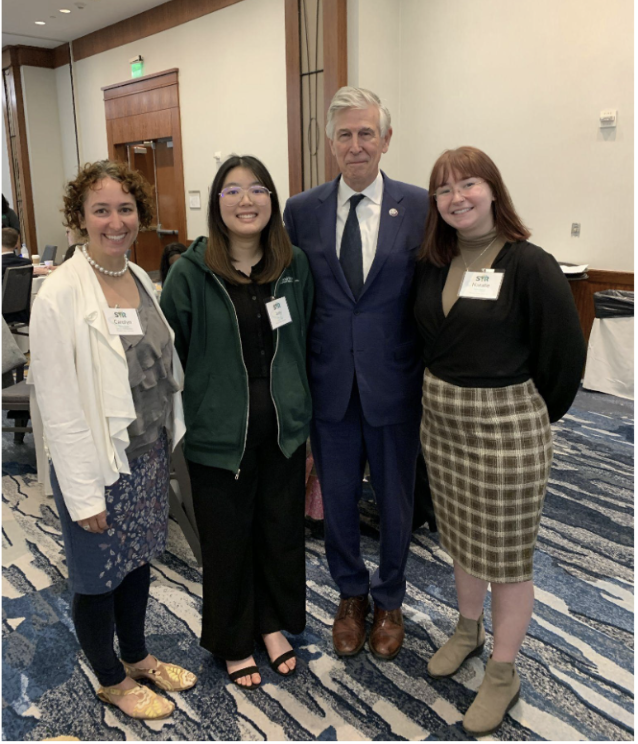
Left to right: Dr. Carolyn Quam, Amy Lin, Congressman Don Beyer, Natalie Robison
In addition to developing my technical and conceptual skills, I undertook leadership roles in the Child Language Learning Center. I became the lead research assistant on the Bilingual Eye Tracking (BET) project by coordinating the team’s weekly meetings and managing our progress in data collection. Additionally, I serve on the lab’s Disability Advocacy committee by ensuring that our public-facing material met accessibility standards. I also serve on the lab’s Social Committee, where we promote a laboratory culture of inclusivity and sensitivity to our various needs as researchers.
Outreach and Perception
I still felt like I was missing the interdisciplinary or collaborative aspect of my neuroscience pursuit. Luckily, I found it in the form of outreach. My work as a tutor prepared me for what would come next: my role as a neuroscience teaching assistant in Psychology.
Perception is a Portland State University course in the Psychology department, and it is also one of the core requirements for the Interdisciplinary Neuroscience minor. It is co-taught by a neuroscientist (Dr. Bill Griesar) and an artist (Jeff Leake) and introduces students to sensory and perceptual systems using an interdisciplinary approach, combining biology, psychology, neuroscience and art.
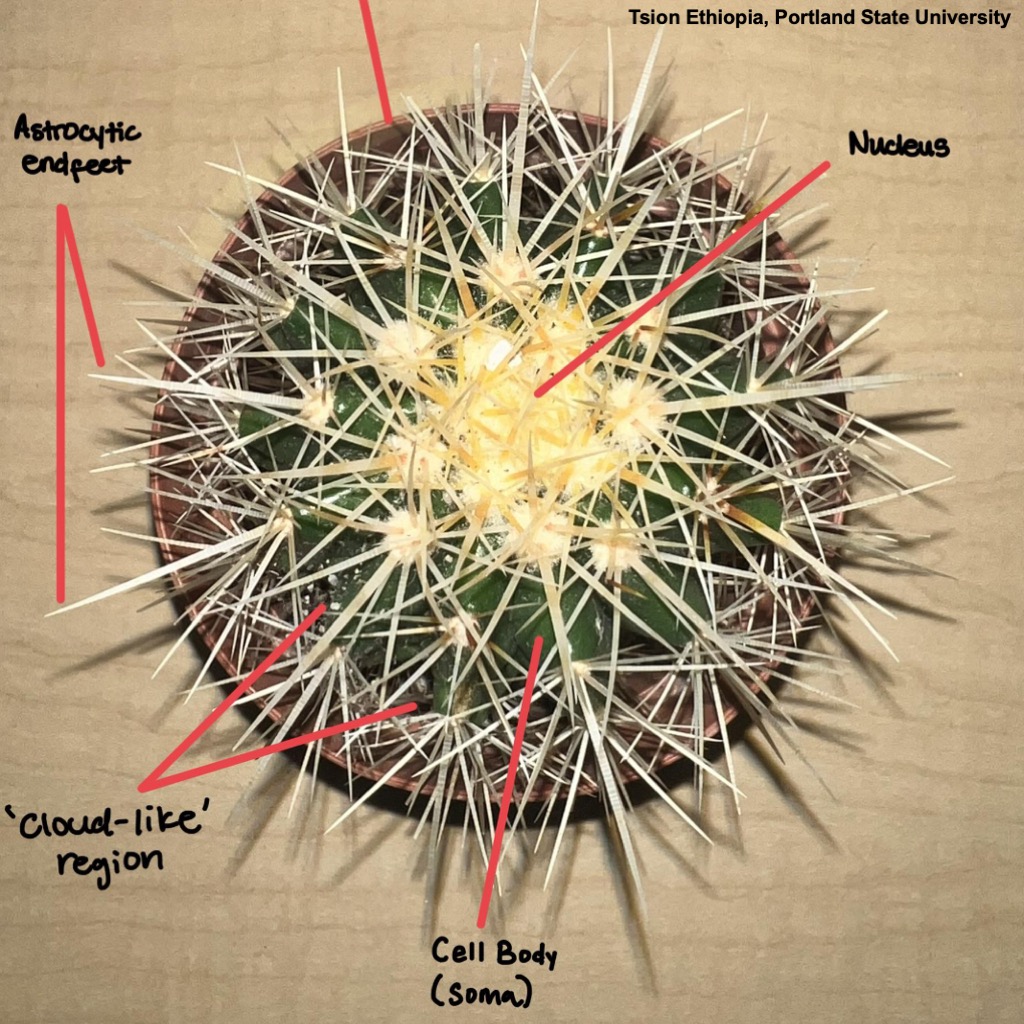
As a teaching assistant I work directly with students of all ages, abilities, and backgrounds to support their introduction to neuroscience. By leading weekly review sessions, answering student questions, and creating student resources, I aim to foster and uplift diverse perspectives. This is a vital aspect of arts-integration in neuroscience, because science is more effective when intersectional and because neuroscience is inherently interdisciplinary.
LEARN MORE: How exactly does diversity make science more effective?
The summer between my junior and senior year at PSU, the BUILD EXITO program recognized my hard work. I was the first BUILD EXITO Scholar to be promoted to the U-RISE Program, where I would continue to participate in undergraduate research and mentoring but with additional support towards my goals in earning a degree in Interdisciplinary Neuroscience.

LEARN MORE: What is U-RISE?
The lack of systemic support in my pursuit of neuroscience
As my senior year began, and I began to prepare for graduate school, I reflected on my academic history. In doing so I realized just how little tangible support there was for those wanting to pursue neuroscience at my institution.
Fall of 2021 was the premiere term of the Interdisciplinary Neuroscience minor at Portland State. The minor was the result of a student-led initiative, which began with data-gathering on both the interests of PSU students in neuroscience as well as the availability of neuroscience to undergraduate students in the Portland area. At the time, there was only one institution offering a major in neuroscience and two offering a minor in neuroscience. As of winter 2023, Portland State University’s unique minor in Interdisciplinary Neuroscience has been the only addition to this list.
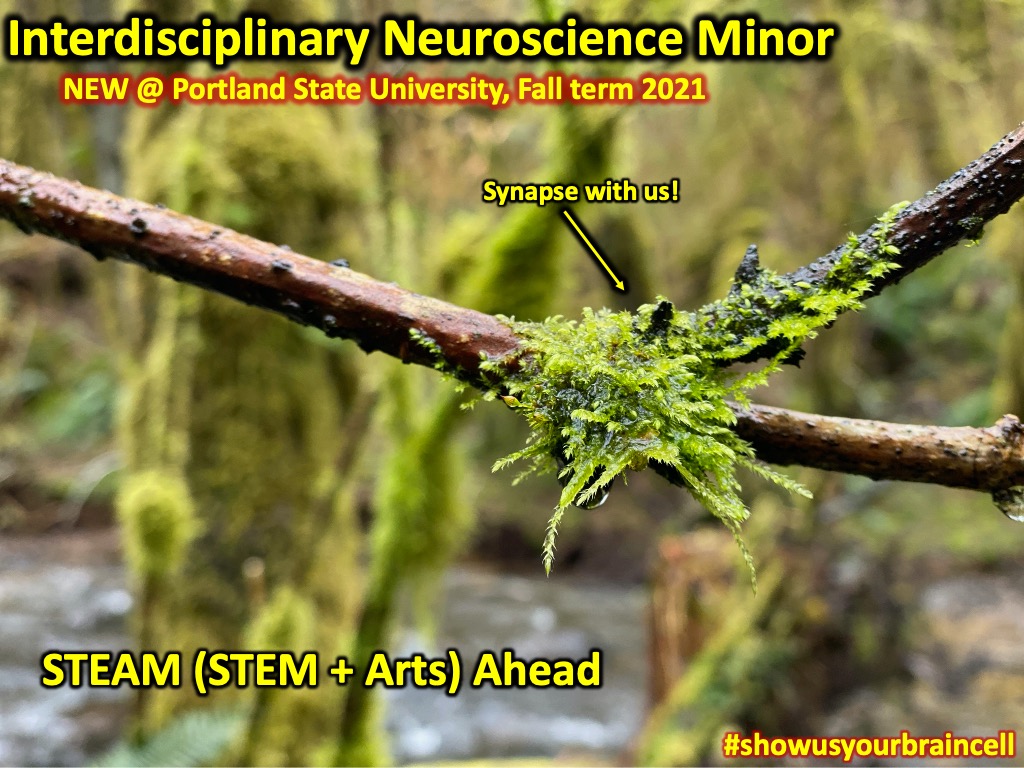
LEARN MORE: STEAM Ahead: A new interdisciplinary neuroscience minor at Portland State!
Bill Griesar is a significant faculty contributor to the Interdisciplinary Neuroscience Minor at PSU. According to Dr. Griesar, there is an imbalance between the needs and the resources provided for neuroscience at PSU. In the Portland area, there are several major institutions with extensive NIH funding for research on the brain, including Oregon Health and Science University (OHSU) and Legacy Research Institute. Portland State University, the primary state university in Oregon’s most populated area, is well-positioned to support neuroscience research via its “strategic alliance” with OHSU. This alliance is the expression of both institutions’ desire to work closely towards shared goals in the biological sciences, and is accessible to students (myself included) via collaborations such as U-RISE, the OHSU-PSU School of Public Health, the Honors College, and the (soon to end) BUILD EXITO Program.
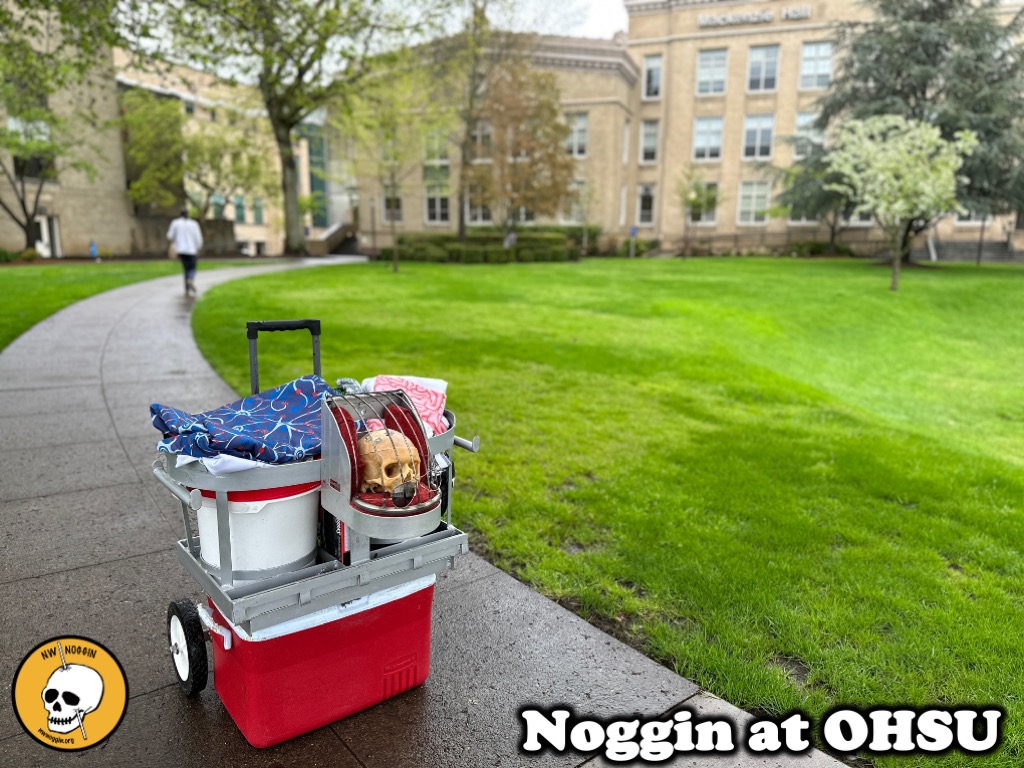
LEARN MORE: Legacy Medical Center will be acquired by OHSU, with the first steps of the merger planned for 2024. How might this change the organization of PSU’s relationship with either institution, and how might this change the access to and funding for neuroscience for PSU students?
The Interdisciplinary Neuroscience Minor began development in Spring 2019 and became formally available to students in Fall 2021. During this time the university launched a “Program Review/Reduction” process in an attempt to achieve financial sustainability. This was established in Fall 2020 and concluded in Spring 2023. As a part of this process, the administration hired a third-party consulting firm, Huron, to provide a deep analysis on the university’s finances and organization. This analysis took place from October 2021 to May 2022. The timelines of these three events are displayed below.

Created using Canva
The Huron report found that declines in PSU enrollment and revenue were greater than what could be attributed to the COVID pandemic – and indicated that the declines are instead partly driven by an overinflated administrative budget.
One of Portland State’s teachers unions, the American Association of University Professors, criticized the university’s decisions to reduce funding for academic programs and student support, as outlined in their 2021 project on “Closing the Gap: Program Review/Reduction Process.”
LEARN MORE: Read the full Huron report here.
Where are the helpers?
The implementation of the Interdisciplinary Neuroscience minor at PSU – at a time when the institution’s funding was under internal review – did not establish any new courses or change the way that existing courses were taught. However it did create significantly more work for teaching faculty. It also relied on extensive volunteer outreach and arts integration efforts by adjunct instructor Jeff Leake. Given that my experiences are only anecdotal, could this information help to contextualize my feelings toward my pursuit of neuroscience?
I’m grateful that the minor requires me to take classes in Psychology, as my Biology major wouldn’t have justified such courses. I’m also grateful for the opportunity to use my undergraduate research experience to develop immersive familiarity with research culture, language and techniques. I felt that even in the Biology courses I’ve taken for the neuroscience minor, neuroscience was only addressed in a foundational way rather than in a way that truly challenged me.
Luckily, I challenge myself: I study Biology as a major, with Neuroscience on the side, along with Speech & Hearing sciences as it relates to my laboratory work, in addition to my work as a teaching assistant and a tutor. If it weren’t for the extensive support for undergraduate research at Portland State University, I’d have had a much more difficult time integrating neuroscience into my undergraduate pathway.
Can I use a (really long) metaphor?
When I was fourteen I was hospitalized and eventually diagnosed with a neurocardiac condition, postural orthostatic tachycardia syndrome with primary orthostatic hypotension.
This diagnosis allowed me to receive the proper treatment for my more severe symptoms (low blood pressure, high heart rate, syncope, seizures). I started taking fludrocortisone, a mineralocorticoid steroid that lowers my heart rate by increasing my blood pressure.
I expected it to help manage my syncope and seizures, but I didn’t expect it to make the moments in-between better as well. For the first time in my life, I could stand up and speak at the same time – without even thinking about it!
Before this, I thought everybody was having to balance feeling lightheaded and controlling their breath with every word while speaking, just probably to a lesser degree than I had to. I wished I could speak to my younger self and say, “what you’re experiencing is not normal and success will be more difficult for you because of it.” That can seem discouraging on the surface, but in reality, recognizing the unfairness of my circumstances gives me permission to feel proud of the victories that others might infantilize.
And now I feel like I’m going through it again, only to a lesser extent.
As I reflect upon my undergraduate experience in my senior year, I am equipped with the tools to critically evaluate my academic achievements. I am so proud of myself, but I cannot help but imagine what I could have accomplished in an environment as dedicated to neuroscience as myself.
Nevertheless, I recognize that the independent nature of my studies has prepared me for my academic future: if I want to become a neuroscience researcher, I already have the self-learning skills which are necessary to develop my expertise.
This is not a success story. This is a call to action.
In fact, this fall Portland Public School teachers went on strike – for the first time in the history of their organization. These K-12 teachers had class sizes that would be as if ONE glial cell were responsible for THIRTY neurons – where many classrooms don’t have enough desks for every student. Portland, Oregon is also the second most unaffordable U.S. city for teachers. Oregon consistently ranks among the lowest ten states in metrics of education. Given this context on Oregon’s primary and secondary education, it is no surprise that postsecondary education is also struggling. Both PPS and PSU have issues that relate to a central point: the allocation and distribution of funding for education.
In the context of Interdisciplinary Neuroscience at Portland State University, it’s not just about the amount of funding provided to support students.
Hire more teachers
As outlined in the Huron report, funding is subjected to “administrative bloat,” reducing the amount that supports students. One way to increase accountability is to structure it in the form of smaller, individual grants, so that the connection between funding and its intended purpose is more direct. In addition to restructuring incoming funds, more funding would also improve PSU’s ability to support neuroscience. By hiring more undergraduate teaching faculty to develop a more diverse course catalog, PSU could improve Interdisciplinary Neuroscience, making it more accessible to students, and better integrate the minor with adjacent fields of study (including the essential interdisciplinary contribution of the arts).

Jeff Leake and Bill Griesar recently advocated for smaller, individual funding support for innovative educators, artists and smaller nonprofits (and not just large, slow-moving institutions), along with Interdisciplinary Neuroscience minor students on Capitol Hill:
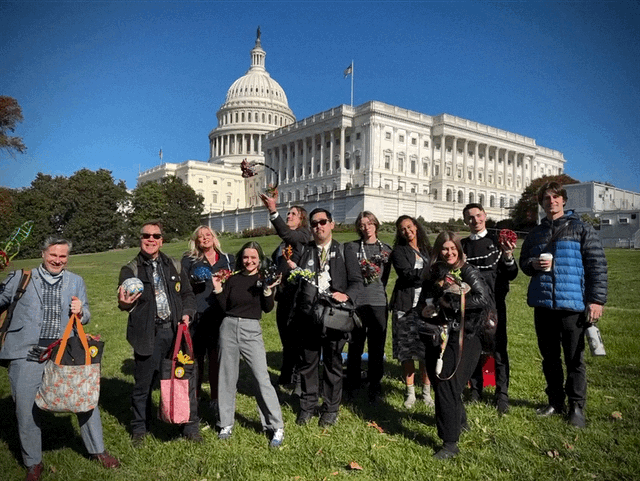
LEARN MORE: Noggin Takes DC
Systemic problems require systemic solutions, and neuroscience is no different. I realize that the best that you and I can do is help raise awareness, strengthen our community connections, and use the power and resources available to us in the direction of positive change.
In summary
Glial cells support neurons the way teachers support students:
- They guide the formation of initial connections
- They provide the resources necessary for growth
- They identify issues and coordinate the response to address them
Why I pursue neuroscience:
- My school district lacked the resources to identify and address issues stemming from complex, intersectional identities
- My personal experience with mental health piqued my interest in neuroscience
- My later experience with tutoring– inadvertently using neuroscience concepts to support students– shaped my fascination with the brain into career goals in neuroscience research
How I’ve navigated neuroscience at Portland State University:
- Major in Biology; Minor in Interdisciplinary Neuroscience
- As a BUILD EXITO Scholar: studied how academic research works, developed my academic identity
- As a URISE Scholar: Develop my plans for postgraduate research and education
- Conducting research at the Child Language Learning Center: Explore the causes and mechanisms driving language attrition using eye tracking, study the neural networks involved in language attrition
The lack of neuroscience support at Portland State University:
- The Interdisciplinary Neuroscience Minor is new, the result of a student initiative which began in 2019
- The tail end of this process was when the university began cutting down on its academic programs and self-evaluating in order to reach financial sustainability
- A part of this process involved hiring a third-party to review the university’s operations, which found that the decline in enrollment and revenue is indicative of administrative bloat
- Neuroscience at PSU is mostly supported indirectly, via undergraduate research and departments like Biology and Psychology, rather than directly, via intentional design of course curriculum or hiring more relevant faculty with interests in teaching neuroscience
What can be done?
- Support your local public teachers, whether they serve K-12 or upper academia!
- Raise awareness: neuroscience needs more support!
- Use your voice, develop community connections!


